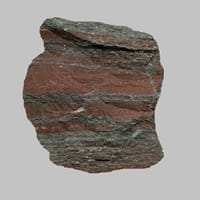Dacite and Jaspillite
Definition
Definition
Dacite is a volcanic igneous rock which is rintermediate in composition between andesite and rhyolite
Jaspillite is an iron rich chemically formed rock which is common in banded iron formation rocks
History
Origin
Romania and Moldova, Europe
Western Australia, Minnesota
Discoverer
Unknown
Unknown
Etymology
From Dacia, a province of the Roman Empire which lay between the Danube River and Carpathian Mountains where the rock was first described
From Jaspilite (Mineral), a compact siliceous rock which resembles jasper
Class
Igneous Rocks
Sedimentary Rocks
Sub-Class
Durable Rock, Soft Rock
Durable Rock, Soft Rock
Family
Group
Volcanic
Not Applicable
Other Categories
Fine Grained Rock, Medium Grained Rock, Opaque Rock
Coarse Grained Rock, Opaque Rock
Texture
Texture
Aphanitic to Porphyritic
Banded, Trellis
Color
Bluish - Grey, Brown, Grey, Light to Dark Grey
Red, Reddish Brown
Maintenance
Less
Less
Durability
Durable
Durable
Water Resistant
No
No
Scratch Resistant
No
No
Stain Resistant
No
No
Wind Resistant
No
No
Acid Resistant
No
No
Appearance
Vesicular
Banded and Glassy
Uses
Architecture
Interior Uses
Decorative Aggregates, Entryways, Interior Decoration
Decorative Aggregates, Interior Decoration
Exterior Uses
As Building Stone, Paving Stone, Garden Decoration
As Facing Stone, Garden Decoration, Paving Stone
Other Architectural Uses
Curbing
Curbing
Industry
Construction Industry
As Dimension Stone, Construction Aggregate, for Road Aggregate, Landscaping
As a Flux in the Production of Steel and Pig Iron, As a Sintering Agent in Steel Industry to process Iron Ore, As Dimension Stone, Cement Manufacture, for Road Aggregate, Making natural cement, Manufacture of Magnesium and Dolomite Refractories
Medical Industry
Not Yet Used
Not Yet Used
Antiquity Uses
Artifacts
Artifacts, Jewellery, Monuments
Other Uses
Commercial Uses
Commemorative Tablets, Creating Artwork
Creating Artwork, Jewelry
Types
Types
Footwall Dacite, Hanging wall Dacite, Tuff and Biotite Dacite
Algoma-type , Lake Superior-type and Superior-type
Features
Host Rock for Lead, Is one of the oldest rock
Is one of the oldest rock
Archaeological Significance
Monuments
Not Yet Used
Used
Famous Monuments
Not Applicable
Data Not Available
Sculpture
Not Yet Used
Not Yet Used
Famous Sculptures
Not Applicable
Not Applicable
Pictographs
Used
Used
Petroglyphs
Used
Used
Figurines
Not Yet Used
Not Yet Used
Fossils
Absent
Present
Formation
Formation
Dacitic magma is formed by the subduction of young oceanic crust under a thick felsic continental plate. Further, the Oceanic crust is hydrothermally altered as quartz and sodium are added.
Jaspillite is a type of sedimentary rock which is formed by the compaction and sedimentation of pieces of broken or weathered rocks and minerals.
Composition
Mineral Content
Amphibole, Apatite, Biotite, Feldspar, Garnet, Hornblade, Magnetite, Plagioclase, Pyroxene, Quartz, Zircon
Coesite, Quartz, Sand
Compound Content
Ca, Fe, Potassium Oxide, Mg, Potassium, Silicon Dioxide
Fe, Iron(III) Oxide, Silicon Dioxide
Transformation
Metamorphism
Yes
No
Types of Metamorphism
Burial Metamorphism, Cataclastic Metamorphism
Not Applicable
Weathering
Yes
Yes
Types of Weathering
Biological Weathering, Chemical Weathering, Mechanical Weathering
Biological Weathering, Chemical Weathering
Erosion
Yes
Yes
Types of Erosion
Chemical Erosion
Chemical Erosion, Coastal Erosion
Properties
Physical Properties
Hardness
2-2.25
3
Grain Size
Medium to Fine Coarse Grained
Large and Coarse Grained
Fracture
Conchoidal
Conchoidal
Streak
White
White
Porosity
Less Porous
Very Less Porous
Luster
Subvitreous to Dull
Earthy
Compressive Strength
Not Available
230.00 N/mm2
6
Cleavage
Perfect
Imperfect
Toughness
Not Available
Not Available
Specific Gravity
2.86-2.87
5.0-5.3
Transparency
Translucent
Translucent to Opaque
Density
2.77-2.771 g/cm3
0-5.7 g/cm3
Thermal Properties
Specific Heat Capacity
0.92 kJ/Kg K
10
3.20 kJ/Kg K
1
Resistance
Heat Resistant, Impact Resistant, Pressure Resistant, Wear Resistant
Heat Resistant, Impact Resistant, Wear Resistant
Reserves
Deposits in Eastern Continents
Asia
Not Yet Found
Russia
Africa
Not Yet Found
Not Yet Found
Europe
France, Greece, Romania, Scotland, Spain
Ukraine
Others
Not Yet Found
Not Yet Found
Deposits in Western Continents
North America
USA
Canada, USA
South America
Argentina, Bolivia, Chile, Colombia, Ecuador, Peru, Venezuela
Brazil
Deposits in Oceania Continent
Australia
New Zealand, South Australia, Western Australia
Western Australia
All about Dacite and Jaspillite Properties
Know all about Dacite and Jaspillite properties here. All properties of rocks are important as they define the type of rock and its application. Dacite belongs to Igneous Rocks while Jaspillite belongs to Sedimentary Rocks.Texture of Dacite is Aphanitic to Porphyritic whereas that of Jaspillite is Banded, Trellis. Dacite appears Vesicular and Jaspillite appears Banded and Glassy. The luster of Dacite is subvitreous to dull while that of Jaspillite is earthy. Dacite is available in bluish - grey, brown, grey, light to dark grey colors whereas Jaspillite is available in red, reddish brown colors. The commercial uses of Dacite are commemorative tablets, creating artwork and that of Jaspillite are creating artwork, jewelry.
|
||
|
||
|










